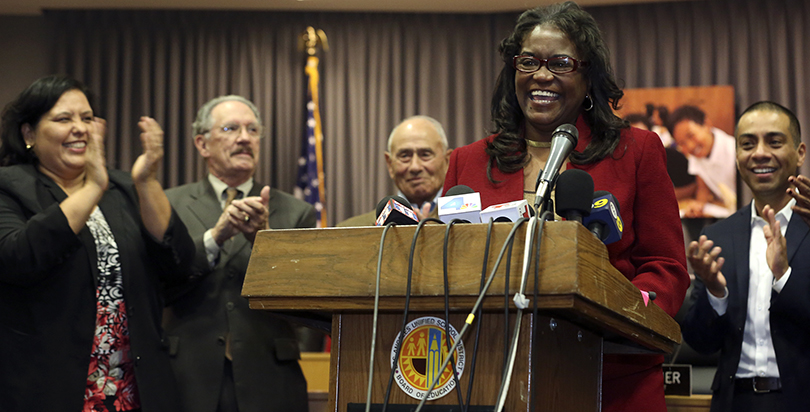Los Angeles School Board Bars Charter Schools From Being Included in New Unified Enrollment System

This article was produced in partnership with LA School Report; see our recent archive of noteworthy features out of LAUSD
After a long and animated discussion at last week’s meeting, the board — which will flip to a pro-reform majority at the end of the month — voted unanimously to approve the first $16.7 million for the system but added an amendment to say charters aren’t welcome in the first two phases.
(Read more about the board’s recent election night sweep by education reformers.)
Some board members argued that charters should never be included, for the sake of the district.
After the 14 hours of meetings on June 13, outgoing board president Steve Zimmer said the debate was “the most significant policy discussion of the day in helping with a potential turnaround for the school district.” Not the budget, not Title I realignments, not the surprise extension of the superintendent’s contract — all part of last Tuesday’s meeting — but keeping charters out of a unified enrollment system was the most important act of the day, Zimmer said close to midnight after the meeting.
“What we have with the unified enrollment is about the rights of children and rights of families making sure they have an excellent choice,” Zimmer said. “If it’s purely an equity program, let’s be blunt and honest about it.”
Zimmer said he has seen improvements and enrollment increases in traditional schools in his district on the west side and said the unified enrollment plan can make it easier for parents to find and enroll in magnet, pilot, and special programs that they may not have known about in their areas. The system could allow a family to make multiple applications at once and rank priorities for schools, such as if it has a basketball team, does it serve dinners, is there a dual-language program, or is it close to home.
Board members also were concerned that some of the district’s lowest-performing schools would fare badly in the new unified enrollment system as families would not include them among their choices. So they added to the amendment a requirement that the superintendent bring a plan “for academic and school climate improvement and enrollment growth within six months” for those schools “identified as under-enrolled and underperforming.”
Superintendent Michelle King is using the unified system as a key component to keeping students in the district’s traditional schools and from leaving for independent charter schools. She noted that the recommendation came from the 2015 report from the Independent Financial Review Panel and that phase one will cost $16.7 million, while the second phase, a year later, will cost an additional $7 million and include adding affiliated charter schools, which are still within the district’s control but have more autonomy.
Affiliated charters and schools for advanced studies will be added for the 2018–19 school year. The first phase starts this fall with option schools, magnets, dual-language programs, early education centers, and more.
King pointed out that the system is designed to help parents more easily find the best schools for their children.
“This is one-stop shopping, where the idea is that families can see everything together at one time in one space and see what’s happening in our district. It is part of our strategic plan,” King said. “Some families don’t know about the great dual-language school that is located down the street — now they can know about it.”
In early discussions over the unified system in committee meetings, there was some discussion that adding charter schools seemed feasible and would be easy to include. About 16 percent of LA Unified students are in charter schools that are independently operated but overseen by the school board, and King has persistently in the past tried to avoid an “us vs. them” dichotomy by saying they are all her students.
A coalition of advocacy groups called PEAPS-LA, Partnership for Equitable Access to Public Schools Los Angeles, has presented ways for how the charters could be included. The district has not acted on those suggestions. And district organizers of the unified enrollment plan said that some charters didn’t want to be included in the plan, and that coordinating application deadlines and schedules would make it impossible.
This could be one of the first things that causes King to head-butt against the incoming board, because two charter-favorable board members will be sworn in next month and both have said they think that independent charters should be included in the unified enrollment system.
School board vice president George McKenna said that including charters would “shoot ourselves in the foot” because families wouldn’t choose district schools. “Charter schools have diminished our district and our enrollment,” McKenna said. “We could have a beautiful rollout of this plan and it will cause the demise of some of our schools.”
McKenna helped propose the amendment directing the superintendent’s office to identify and help the district’s unsuccessful and under-enrolled schools “and try to resurrect them from extinction” if they don’t seem like palatable options in the unified enrollment system.
“Until we are willing to say how to fix the school, we can’t fix it,” McKenna said. “Are we willing to admit we don’t know how to fix it? I think we have the expertise and know-how. It’s not all about just kids graduating. I want my kids to be educated too.”
Outgoing board member Mónica Ratliff noted that the spending on the system is a huge sum of money and that “if you open this to charter schools, you may as well not do it.”
Pointing out that her record shows she is definitely not anti-charter, Ratliff said, “This is for traditional public schools, and some charters don’t even want to be part of it. You will have some parents say that we’re not telling them about all their options, but I think we should not include charters in the mix.”
Ratliff calculated that if the district could recruit and keep 2,383 more students, the unified enrollment system would pay for itself.
The question for the board, Zimmer noted, is designing how to best help families enroll in a school of their choice. “We need to agree whether this is the best way to do it,” Zimmer said.
Wording to the resolution also included foster youth, with the total amendment reading: “Up to 2% of the total number of applicable seats under the Unified Enrollment program will be reserved for Foster Youth which will be held through the first week of school, in accordance with District policies and all laws and regulations. Unclaimed seats would be released to students on the waiting list. Phase 1 and Phase 2 of the Unified Enrollment plan are exclusively for LAUSD schools and when schools are identified as under enrolled and underperforming the Superintendent will bring a plan to the Board for academic and school climate improvement and enrollment growth within 6 months.”
At some point, charters and even private schools could be included, and maybe even pay to be part of the program, Ratliff suggested.
“This is an important discussion, and what I love is that it focuses on our schools and their performance,” said Ratliff, who noted that some schools that were actually doing well with some programs were falsely perceived by the neighborhood as not good, and unified enrollment could help that. “We are asking that this not be open to non-LAUSD traditional public schools, and that’s bold.”
King noted that the staff needs to hire a company to coordinate the project but added that already 155,000 families are enrolled in a test of the program at apply.lausd.net.
Mónica García, a vociferous charter supporter, agreed with the amendment for underperforming schools and said, “This project is about serving people better. The challenge for this board is to avoid doing everything the same. We need to recognize that people are leaving us because they are not getting what they need.”
Get stories like these delivered straight to your inbox. Sign up for The 74 Newsletter

;)
